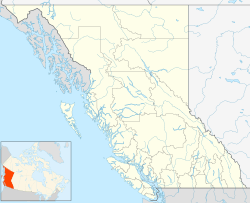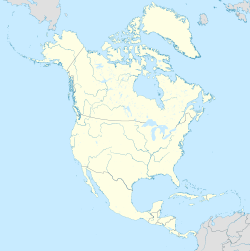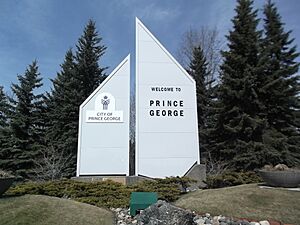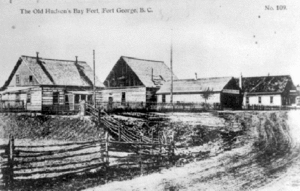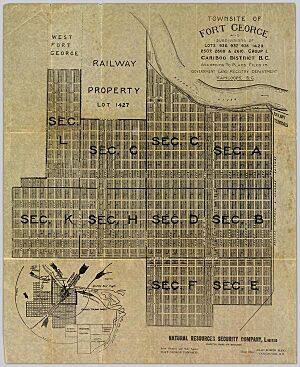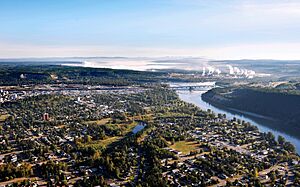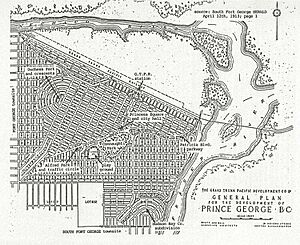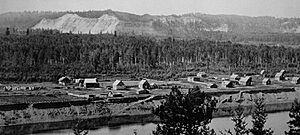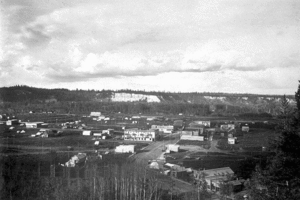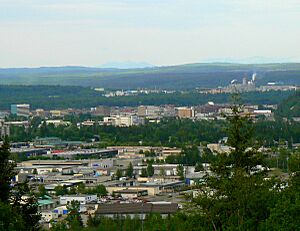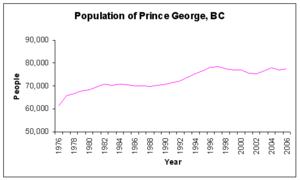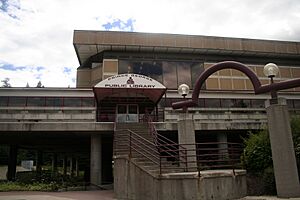Prince George, British Columbia facts for kids
Quick facts for kids
Prince George
|
|||
|---|---|---|---|
| City of Prince George | |||
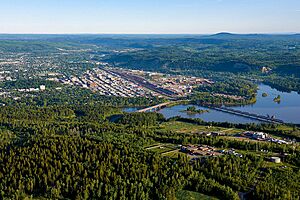
An aerial view of Prince George
|
|||
|
|||
| Motto(s):
"Shaping a Northern Destiny"
|
|||
| Country | Canada | ||
| Province | British Columbia | ||
| Regional district | Fraser–Fort George | ||
| Established | 1807 | ||
| Incorporated | March 6, 1915 | ||
| Area | |||
| • City | 318.26 km2 (122.88 sq mi) | ||
| • Urban | 73.9 km2 (28.5 sq mi) | ||
| Elevation | 575 m (1,886 ft) | ||
| Population
(2021)
|
|||
| • City | 76,708 | ||
| • Density | 242.2/km2 (627/sq mi) | ||
| • Urban | 67,339 | ||
| • Metro | 89,490 | ||
| Time zone | UTC−08:00 (PST) | ||
| • Summer (DST) | UTC−07:00 (PDT) | ||
| Forward sortation area |
V2K – V2N
|
||
| Area code(s) | 250, 778, 236, 672 | ||
Prince George is a city in British Columbia, Canada. It sits where the Fraser and Nechako rivers meet. The city has about 76,708 people, and the larger metro area has about 89,490. People often call it British Columbia's "northern capital." This is because it's a major center for learning, health care, government, arts, entertainment, sports, and supporting big industries like forestry and mining.
Contents
History of Prince George
The story of Prince George began with a fur trading post called Fort George. It was set up in 1807 by Simon Fraser for the North West Company. He named it after King George III. This area was the homeland of the Lheidli T'enneh First Nation. Their name means "people of the confluence of the two rivers."
Early Settlements (1800s)
For many years, the Fort George trading post stayed small. Fort St. James was the main trading hub in the New Caledonia region. Even during the Cariboo Gold Rush, Fort George was not part of the new trade routes. The Collins Overland Telegraph Trail built in 1865–67 also went around it. In the late 1800s, many Lheidli T'enneh people lived near the trading post. This made it easy for them to trade furs without traveling far.
Railway and Town Growth
In 1903, things started to change for the area. Reports said the Grand Trunk Pacific Railway (GTP) would pass nearby. In 1906, people began to settle and farm around the trading post. Then, in 1909, two companies started building rival towns. These were South Fort George and Fort George (also called Central Fort George).
Fort George Townsite
The Fort George townsite was built about 3.2 kilometers northwest on the Nechako River. A company called Natural Resources Security Company bought land there. Its CEO, George Hammond, advertised Fort George as the future "Chicago of the north." He claimed it had mild winters and was great for farming. He even advertised buildings that didn't exist yet! Lots sold for $400 in 1912, and up to $1,000 by 1913.
Ten paddle steamer sternwheelers came up the Fraser River from Soda Creek. They docked at both South Fort George and Fort George Townsite.
South Fort George
South Fort George grew near the old Hudson's Bay Company post along the Fraser River. Lots went on sale in 1910. Paddle wheelers from the BC Express Company landed here. This area grew because people thought the railway was coming. South Fort George remained its own community until 1976. Then, it became part of the City of Prince George.
How Prince George Was Created
People bought properties in both towns, hoping the railway would make them rich. By 1913, South Fort George and Fort George each had about 1,500 people. They were busy places, as thousands of railway workers came for supplies and fun. Both towns hoped the Grand Trunk Pacific station would be built in their area.
However, the railway bought 553 hectares of land between the two towns from the Lheidli T'enneh. By 1914, when the railway was finished, there were four main communities: South Fort George, Fort George Townsite, the Millar Addition, and the railway's own townsite, Prince George. The railway built its station in Prince George.
The railway's land, now known as the City of Prince George, officially became a city on March 6, 1915. It followed the borders of the 553 acres the railway first bought. As Prince George grew, many buildings from the older towns were moved into the new city.
Lheidli T'enneh Village and the Railway
In 1908, the Grand Trunk Pacific Railway wanted the Lheidli T'enneh's Reserve No.1 land for a railway and station. The Department of Indian Affairs wanted to protect the Lheidli T'enneh's rights but also supported the railway.
Between 1908 and 1911, the railway and others made offers for the land. In 1910, Chief Louis of the Lheidli T'enneh said his people were very connected to their land. A vote was held, and it was very close. The Lheidli T'enneh did not consider the vote final. They asked for more money, which was refused. A new vote by the Band then turned down the sale completely.
In 1911, the Lheidli T'enneh agreed to sell Reserve No.1 for $125,000. This included money for building on other reserves and keeping their old village cemetery. They agreed to move by June 1912. However, there were delays in building the new village. The old village was later destroyed to make sure people moved.
The new village was built further away from Prince George. The land was not good for farming, and the Lheidli T'enneh faced economic hardship. The site of the old village is now Lheidli T'enneh Memorial Park. The cemetery became Reserve No.1A.
Naming Prince George
There were three reasons given for the name Prince George:
- In 1911, railway papers said the name would help tell it apart from other Fort George areas.
- In 1914, the railway said it would honor the recently crowned King George V.
- Another reason was to honor Prince George, Duke of Kent, the fourth son of King George V.
People in Fort George tried to stop the new name but failed. In May 1915, residents voted to name the city Prince George (153 votes to 13).
World Wars and Growth
When World War I started in 1914, the local economy suffered. Many men joined the army, and railway construction stopped. The population dropped. The Spanish flu epidemic in 1918 also caused many deaths.
Prince George struggled through the 1920s and the Great Depression of the 1930s. It didn't grow much until World War II. An army camp was built near Cranbrook Hill, bringing new life to businesses. Air travel also grew in the 1930s. Prince George became a hub for air mail. In 1939, construction began on what is now Prince George Airport.
During WWII, Army Camp Prince George housed up to 6,000 soldiers. After the war, demand for lumber increased as European cities rebuilt. Prince George, with its many sawmills and spruce trees, became very successful. In 1952, the Pacific Great Eastern railway was finished. It connected with the CN line in Prince George. With Highways 16 and 97 also completed, Prince George finally became a major hub for British Columbia.
Modern History
In 1953, the Fort George Townsite became part of the City of Prince George.
On June 25, 1956, a Lockheed P-38 Lightning fighter plane crashed near the city center. The pilot and a 15-year-old passenger died. The wreckage is still there.
In 1964, the first pulp mill was built, followed by two more in 1966. This led to a need for new schools and housing. New neighborhoods like Spruceland and College Heights were built. In 1975, Prince George expanded its borders. It included the Hart area, Pineview, and South Fort George.
Low-lying areas near the rivers can flood when ice jams form. In late 2007, a large ice jam on the Nechako River caused widespread flooding. A special "Warm Water System" was built to melt the ice.
In 2011, a detachment of the Rocky Mountain Rangers Army Reserve unit was formed in Prince George. The city also hosted the 2015 Canada Winter Games.
Geography of Prince George
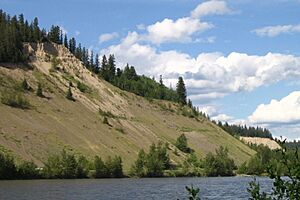
Prince George is in the Regional District of Fraser-Fort George. It's located where the northern and southern parts of the Rocky Mountain Trench meet. The city has different areas: South Fort George, the Hart (north of the Nechako River), College Heights (southern residential and commercial), and the Bowl (the valley with downtown). The steep banks of the Nechako River, called cutbanks, are a famous natural feature.
You can find wild edible fruits here like bunchberries, rose hips, blueberries, cranberries, chokecherries, strawberries, raspberries, saskatoons, and soapberries. Morel mushrooms also grow in this area.
Climate in Prince George
Prince George has a humid continental climate. Winters are milder than you might expect for the location. The average temperature in January is -9.6°C. There are about 38 days from December to February where the temperature reaches or goes above freezing. However, very cold Arctic air can sometimes stay over the city for weeks.
Summer days are warm, with a July high of 23.1°C. But nights are often cool. There is some rain all year, but February to April is the driest time. The airport gets about 205.1 cm of snow each year. Snow usually falls between October and May.
The highest temperature ever recorded was 39.8°C on June 28, 2021. The lowest was -50.0°C on January 2, 1950.
City Services
Prince George gets its drinking water from the Nechako and Fraser Rivers. The water is cleaned with sodium hypochlorite. The city treats sewage at a facility on the Fraser River. In 2014, people voted to stop adding fluoride to the drinking water. This change happened in December 2014.
Air Quality
Prince George's air can have many pollutants. These come from pulp mills, sawmills, an oil refinery, vehicles, trains, and heating homes. Because the city is in a valley, sometimes pollutants get trapped. This can lead to poor air quality in some areas.
People and Population
In the 2021 Census, Prince George had 76,708 people living in 31,793 homes. This was a 3.7% increase from 2016. The larger metro area had 89,490 people.
In 2001, 23% of homes had one person, and 31% were married couples with children. Only 14% of adults aged 20-64 had a university degree.
Diverse Communities
Prince George is home to people from many different backgrounds. The largest groups are people of European descent and Indigenous people. There are also growing communities of South Asian, Southeast Asian, East Asian, and African people.
Beliefs and Religions
According to the 2021 census, most people in Prince George (59.5%) do not follow a specific religion. About 34.4% are Christian. Other religions include Sikhism (3.2%), Hinduism (0.8%), and Islam (0.7%).
Economy and Jobs
In the early 2000s, Prince George's economy became mostly about service industries. The Northern Health Authority, based in Prince George, has a large budget and invests a lot in health care buildings. In 2012, the BC Cancer Agency's Centre for the North opened here. It offers modern cancer care.
Education is also a very important part of the city's economy. The University of Northern British Columbia, the College of New Caledonia, and School District #57 bring a lot of money into the local economy each year.
For most of the 20th century, Forestry was the main industry. This included making plywood, running many sawmills, and having three pulp and pellet mills. These businesses were major employers. Mining exploration and development might be a big part of Prince George's future.
Other industries include chemical plants, an oil refinery, a brewery, and a dairy. Prince George is also a major center for transportation, trade, and government services. Many big stores are opening in Prince George, and more are expected.
Education and Learning
Prince George has 40 English-speaking elementary schools, eight secondary schools, and eight private schools. There is also a French-speaking elementary and secondary school.
For higher education, there's the College of New Caledonia (CNC). It offers two-year university courses, as well as job training programs. Several BC universities and other learning centers work with CNC. Prince George also has Guardian Aerospace Flight School.
The University of Northern British Columbia (UNBC) was started in 1990. It offers many undergraduate, master's, and PhD programs. It also has a Northern Medical Program with the University of British Columbia. UNBC's campus is on a hilltop with views of the Rocky Mountains. In 2015 and 2016, UNBC was ranked the top small university in Canada by Maclean's.
The College of New Caledonia (CNC) serves central British Columbia. It started in Prince George in 1969 and has grown to other towns. CNC enrolls about 5,000 students each year in about 90 different programs. These include business, health sciences, trades, and social services. Many of these programs are available at CNC Prince George. CNC also offers university classes that can transfer to universities in BC, Alberta, and other places.
Sports and Fun
| Club | Sport | League | Venue |
| Prince George Cougars | Ice hockey | Western Hockey League (WHL) | CN Centre |
| Prince George Spruce Kings | Ice hockey | British Columbia Hockey League (BCHL) | Prince George Coliseum |
| Northern BC Centre for Skating | Ice skating | Skate Canada (BC/YT) | Elksentre Arena |
| UNBC Timberwolves | Soccer | U Sports | Masich Place Stadium |
Prince George has several sports teams. These include the Prince George Cougars (hockey) and the Prince George Spruce Kings (hockey). Many National Hockey League players have come from Prince George, like Dan Hamhuis and Sheldon Souray.
The city has 116 playgrounds and parks, fields for baseball, soccer, and lacrosse, and eight golf courses. There are also tennis courts, ice rinks, and roller rinks. The new Aquatic Centre and the CN Centre (a large arena) are popular. For hikers, there's an 11 km system of trails along the river called the Heritage Trails. Four provincial parks nearby offer downhill, cross-country, and heliskiing.
Parks in Prince George include:
| Park | Notes |
| Lheidli T'enneh Memorial Park | formerly known as Fort George Park |
| Paddlewheel Park | Located in South Fort George, where paddle wheeler boats used to land. |
| Rainbow Park | |
| Connaught Hill | Behind City Hall, offers great views of the city. |
| Foot Park | |
| L.C. Gunn Park | Trail on the east side of the Fraser River. |
| Ginter's Property | |
| Eskers Park | |
| Forests for the World | |
| Cottonwood Island Park | Trails along Cottonwood Island. |
North of Prince George, you can find the Huble Homestead and Giscome Portage. The Otway Nordic Centre has over 40 km of groomed trails for cross-country skiing, with 5 km lit for evening skiing.
For racing fans, the Prince George Auto Racing Association (PGARA) has various events at the PGARA Speedway. The Prince George Rod and Gun Club has ranges for shooting sports.
Prince George also has a Pride Centre for all LGBTQ and ally members. It offers a safe space and support. The city has nightclubs, sports bars, pubs, and fine dining. There's also the Treasure Cove Hotel and Casino.
For movies, you can go to the Cineplex Entertainment six-plex or the Park Drive-in Theatre. Cinema CNC also shows art films.
Arts and Culture
Prince George has a big off-road motorcycle community. There are several motocross tracks and many trails for motorcycles.
Art and Creativity
- The Two Rivers Gallery opened in 2000. It has two exhibition galleries, a gift shop, and offers guided tours and art classes for all ages.
- Studio 2880 is home to groups for artists, quilters, potters, weavers, and spinners. Its sister building, Studio 2820, has a gift shop.
Theatres and Performances
Prince George has a history of theatres. The Princess Theatre opened in 1914, and the Rex Theatre opened that December. The Dreamland Theatre also moved to George Street in 1915. These theatres showed movies, and sometimes hosted live shows, concerts, and meetings.
Over the years, theatres changed hands and names. The Capitol Theatre was demolished in 1934. The Princess Theatre was used as a dance hall and community center before becoming a movie theatre again.
Live Theatre and Music
- Theatre Northwest is a professional theatre company that puts on plays all year.
- The Prince George Theatre Workshop Society is an amateur theatre group that performs throughout the year.
- The Prince George Playhouse hosts amateur and professional theatre, musical events, and plays by local businesses.
- The Prince George Symphony Orchestra (PGSO) is a mix of professional and semi-professional musicians. They play concerts each year in the city and sometimes tour other communities.
- The Street Spirits Theatre Company is a youth theatre group. They create and perform interactive plays about community issues. They have also made several movies.
In 2005, a cultural project placed 'Spirit Bears' around the city. These are fiberglass bear statues painted with different scenes.
Museums and Libraries
- The Exploration Place Museum and Science Centre is in Lheidli T'enneh Memorial Park. It has exhibits on paleontology (dinosaurs and fossils), First Nations history, a children's gallery, and the Prince George Sports Hall of Fame. It also has a narrow gauge Fort George Railway with a working steam train.
- The Prince George Railway and Forestry Museum opened in 1986. It has one of the largest collections of old trains in the province. You can see vintage rail cars, locomotives, and historical buildings. There are also old firetrucks and forestry equipment. A mini-train goes around the museum.
- The Prince George Public Library has two branches: the Bob Harkins branch downtown (the main library) and the smaller Nechako branch in the Hart. The College of New Caledonia and University of Northern British Columbia also have libraries for local residents.
City Landmarks
Mr. PG was built in 1960. He is a symbol of how important the forest industry is to Prince George. He used to be able to speak and bow! Today, Mr. PG stands where Highway 97 and Highway 16 meet. He is 8.138 meters tall, and his head is 1.5 meters wide.
Famous People from Prince George
Many notable people have connections to Prince George, including:
- Murray Baron, former NHL hockey player
- Shirley Bond, a politician
- Zdeno Chára, a Slovak hockey player who played for the Prince George Cougars
- Denise Chong, a writer
- Jon Cooper, an NHL coach
- John Furlong, who led the 2010 Vancouver Olympics
- Dan Hamhuis, former NHL hockey player
- Chris Mason, former NHL goaltender
- Meryeta O'Dine, an Olympic snowboard medalist
- Darcy Rota, former NHL hockey player
- Sheldon Souray, former NHL hockey player
- Alyxandria Treasure, an Olympic high jumper
Getting Around Prince George
Prince George is a major transportation hub for northern British Columbia. It sits where Highways 97 and 16 cross. Many trucks pass through the city, and there are places to fix trucks and heavy equipment.
The streets in the "Bowl" area are set up in a grid. Streets run north-south and are named alphabetically. Avenues run east-west and are numbered. In downtown, the grid is turned a bit. Streets are named after Canadian cities and provinces.
Prince George Airport is just south of the city. It's an airport of entry and can handle large planes. In 2016, over 462,000 passengers used the airport. You can fly to Vancouver and Calgary daily. There are also flights to smaller towns and seasonal flights to Mexico.
CNR freight trains operate out of Prince George. Via Rail passenger trains also stop here; the Jasper–Prince Rupert train stays overnight at the Prince George station.
Local public transportation is provided by the PG Transit bus service.
Annual Events
- The British Columbia Northern Exhibition (BCNE) started in 1912. It's the city's biggest summer event, held every August. It has rides, food, shows, and competitions.
- The Canada North Resources Expo began in 1985. It shows the latest in forestry, oil and gas, mining, and transportation technology.
- Downtown Summerfest is a street party held every August in downtown Prince George. It has entertainment, vendors, and food from local restaurants.
- Kiwanis AleFest is a craft beer festival held in late January.
- The Prince George Coldsnap Festival is a national folk music festival held in winter at different places around the city.
- The Snow Daze Winter Festival is held each February. It includes events like the Mr. PG pageant, curling, and snow golf.
- Prince George celebrates BC River's Day on the last Sunday in September with a free music festival.
- The Father's Day Show and Shine is held in Lheidli T'enneh Memorial Park. It features vintage and modern cars.
- The Prince George Iceman Multi-sport race usually happens in February. It includes skiing, running, ice skating, and swimming. People can compete alone or in teams.
See also
 In Spanish: Prince George (Columbia Británica) para niños
In Spanish: Prince George (Columbia Británica) para niños




